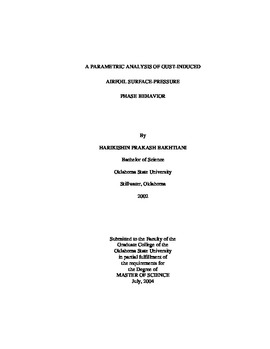| dc.contributor.advisor | Falk, Eric A. | |
| dc.contributor.author | Bakhtiani, Harikishin Prakash | |
| dc.date.accessioned | 2014-04-17T19:51:53Z | |
| dc.date.available | 2014-04-17T19:51:53Z | |
| dc.date.issued | 2004-07-01 | |
| dc.identifier.uri | https://hdl.handle.net/11244/9887 | |
| dc.description.abstract | The current study investigates chordwise phase distributions on two-dimensional lifting surfaces using computational fluid dynamic (CFD) analysis, particularly through the CFD software FLUENT 6.0. A series of CFD simulations are performed in which convecting two-dimensional fluid dynamic disturbances are allowed to propagate over a variety of lifting surfaces (or airfoils). These unsteady forcing scenarios examine the most basic chordwise phase behavior, focusing on the influence of airfoil thickness, camber, mean loading, and neighboring surfaces (e.g., a cascade of airfoils). Finally, a comparison between the computed phase results and experimental data is conducted, in an attempt to provide a definitive explanation of the observed experimental phase trends. Unsteady surface-pressure results correlate with previous investigations indicating accurately modeled flow physics. Unsteady pressure amplitudes on the lifting surfaces exhibit leading edge amplification decaying rapidly downstream. Spectral analyses show surface-pressure harmonic frequencies reaching four times the aerodynamic forcing frequency. First-harmonic phase data exhibit ambiguous disturbance position-vs.-phase maps, from which disturbance propagation direction can not be inferred. Based on the results of a previous investigation, the ambiguous phase results suggest the existence of multiple disturbance interactions across the airfoil, these disturbances having the same primary frequency, but different amplitudes and propagation speeds. A first-order disturbance-interaction model developed in an attempt to reproduce the ambiguous phase behavior, provided evidence suggesting phase-map ambiguity results from interaction between local convectively propagating and global acoustically propagating pressure waves. Parametric results indicate increase in mid-chord phase slope as lifting-surface thickness and camber were increased. However, as angle-of-attack increased a mere shift in the mid-chord phase slope variation towards the leading edge was observed. Finally, the computed results compared favorably to results collected in a previous experiment. Phase data exhibited similar ambiguity to that seen in the experimental results, further suggesting the existence of convectively propagating and acoustically propagating wave interaction. | |
| dc.format | application/pdf | |
| dc.language | en_US | |
| dc.publisher | Oklahoma State University | |
| dc.rights | Copyright is held by the author who has granted the Oklahoma State University Library the non-exclusive right to share this material in its institutional repository. Contact Digital Library Services at lib-dls@okstate.edu or 405-744-9161 for the permission policy on the use, reproduction or distribution of this material. | |
| dc.title | Parametric Analysis of Gust-Induced Airfoil Surface-Pressure Phase Behavior | |
| dc.type | text | |
| osu.filename | Bakhtiani_okstate_0664M_1076.pdf | |
| osu.college | Engineering, Architecture, and Technology | |
| osu.accesstype | Open Access | |
| dc.description.department | Mechanical & Aerospace Engineering | |
| dc.type.genre | Thesis | |
| dc.subject.keywords | cfd | |
| dc.subject.keywords | gust-induced | |
| dc.subject.keywords | phase | |
| dc.subject.keywords | fluent | |
| dc.subject.keywords | airfoil | |
| dc.subject.keywords | cascade | |
